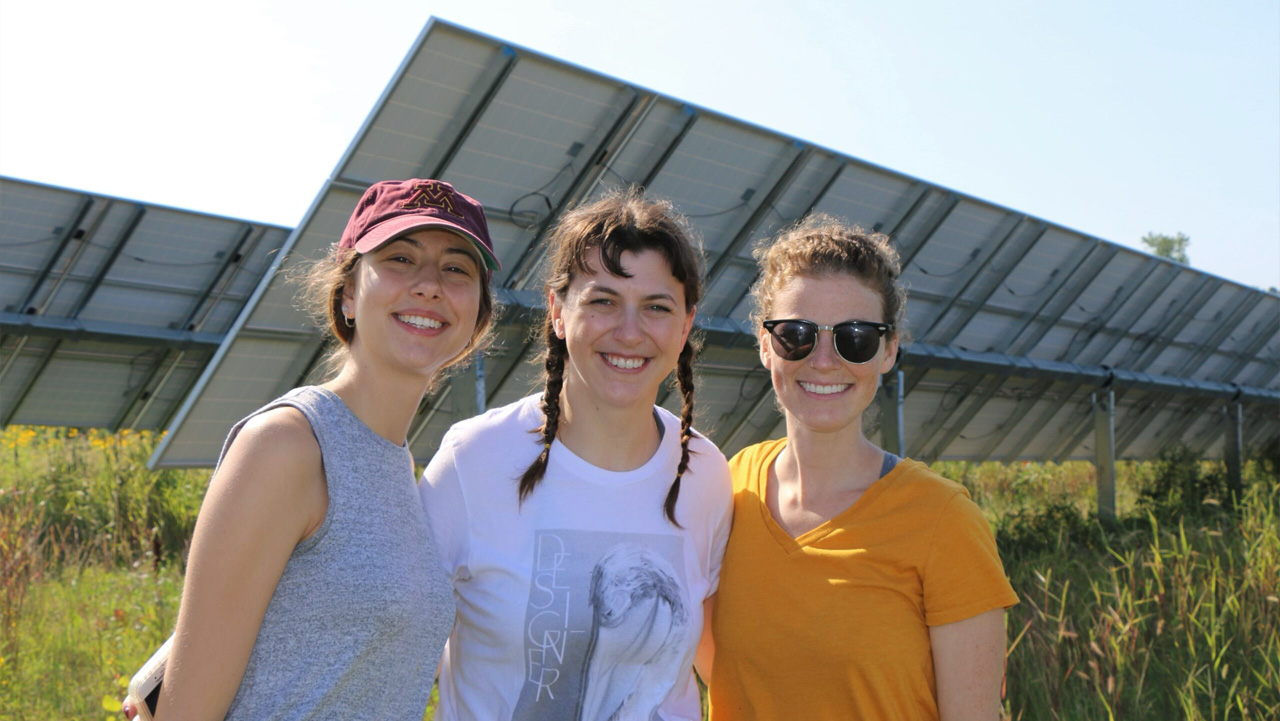
As climate policies advance across the nation, Minnesota and the Midwest have made remarkable strides in transitioning our electricity system from fossil fuels to clean energy. Minnesota just hit a major milestone: Electricity sector emissions are down 50% from 2005, putting us halfway to full decarbonization. This stands as our greatest decarbonization success story so far, demonstrating how smart policies and technological innovations can drive meaningful climate progress. Here in Minnesota, policies like the 2007 Next Generation Energy Act and the 100% clean electricity law have helped Minnesota make huge strides in mitigating the worst effects of climate change.
So where does Minnesota’s electricity sector stand twenty years after the 2005 Kyoto Protocol and 25 years before we must be net-zero? This post provides a snapshot of where we are and how far we’ve come in decarbonizing our electricity sector. We’ll start by looking at Minnesota as a whole, then the larger Midwestern electric grid, before zooming in to look at a handful of specific electric utilities and co-ops in the state.
Minnesota’s electricity sector is getting much cleaner
Our electricity generation sector is decarbonizing faster than any other part of Minnesota’s economy. Once the state’s largest source of greenhouse gas (GHG) emissions, electricity generation now accounts for approximately 20% of Minnesota’s in-state emissions, falling below the transportation and agriculture sectors. Since 2005, electricity-related emissions have plummeted by an impressive 50%, primarily by switching from coal to cleaner energy sources.
This transformation is clearly visible in Minnesota’s changing electricity generation mix, as seen in Chart 1 below. Over the past two decades, we’ve witnessed a dramatic shift away from coal toward natural gas and carbon-free sources like hydro, nuclear, wind, and solar — the latter two exploding in growth over the past decade. Minnesota’s electricity sector used to be the largest source of GHG emissions in the state; today, it’s our biggest success story for how to decarbonize.
Chart 1: Declining CO2 Emissions as Minnesota Shifts to Cleaner Electricity

As coal plants have retired across the state, they’ve been replaced with renewable energy facilities that generate electricity without carbon emissions. Look no further than Sherco Solar, the under-construction largest solar and battery project that’s replacing the state’s largest coal plant.
Thanks to Minnesota’s landmark 100% clean electricity law, along with the cost-effectiveness of clean technology and ongoing regulatory work, we’re well-positioned to continue this downward emissions trajectory. The economics increasingly favor clean energy, with new wind and solar consistently outcompeting fossil fuel alternatives on price.
MISO, the Midwest electricity grid, is getting cleaner with room to grow
Minnesota is part of the Midwest Independent System Operator (MISO), which manages the electric grid across much of the Midwest. Like Minnesota, the broader MISO region has made significant progress in reducing its GHG emissions — but there’s still considerable work ahead.
When our regional grid was originally built, coal-fired power plants were the standard source of electricity generation. Today, that picture has changed, with renewables and natural gas steadily replacing coal’s once-dominant position. As this transition continues, GHG emissions across the Midwest have declined substantially, as can be seen in Chart 2 below.
Chart 2: Declining CO2 Emissions as Midwest Shifts to Cleaner Electricity

Another way we can look at the transition of MISO’s fuel mix is to look at the carbon intensity of MISO’s electricity generation, a measure calculated by dividing the total emissions of the system by the total electricity produced. Since 2003, MISO’s carbon intensity has decreased from 1,680 pounds of CO2 per megawatt-hour (MWh) to 1,020 pounds, representing a nearly 40% reduction, as seen in Chart 3 below.
Chart 3: Declining Carbon Intensity as Midwest Shifts to Cleaner Electricity

Still, our region has progress to make. Compared to other regional grids across the United States, MISO has a ways to go to improve its fuel mix and transition to carbon-free sources, as seen in Chart 4 below. Fortunately, the Midwest has tremendous untapped potential for clean electricity from wind, solar, and battery storage. These resources are increasingly being developed across the region, helping to accelerate our decarbonization while ensuring reliable energy for all Midwesterners.
Chart 4: Share of Total Electricity Generation by Fuel Type by Regional Electric Grid

How clean are Minnesota’s electric utilities?
Xcel Energy serves approximately 1.6 million Minnesotans, primarily in the Minneapolis-St. Paul metro area. Their 2024 fuel mix is 64% carbon-free according to a recent filing, representing a 61% reduction in GHG emissions compared to its 2005 emissions. In 2024, Xcel Energy’s Upper Midwest system generated its electricity from wind (29%), natural gas (26%), nuclear (23%), coal (10%), other renewables (7%), solar (4%), and other (1%). In its most recent long-range plan that was approved in February 2025, Xcel Energy plans to build 3,430 MW of wind, 550 MW of solar, and 1,236 MW of battery storage by 2030.
Minnesota Power provides electricity to 150,000 residential and commercial customers, including to iron mines, mills, and other heavy industry customers on Minnesota’s Iron Range. According to a recent filing, Minnesota Power’s 2024 fuel mix was 55% renewable energy. The utility aims to supply 70% of its energy from renewables by 2030 and has a goal to achieve 80 percent carbon reductions by 2035, compared to 2005 levels. As of this writing in April 2025, Fresh Energy is currently engaging as a stakeholder in Minnesota Power’s long-range plan with the Minnesota Public Utilities Commission.
Great River Energy is a wholesale electric power cooperative providing electricity to 1.7 million customers through 26 member-owned cooperatives across Minnesota. According to their 2024 Annual Report released in April 2025, Great River Energy generates 44% of its electricity from carbon-free resources, primarily wind energy.
Connexus Energy, the state’s largest member-owned electric cooperative, serves approximately 146,000 customers and was nearly 50% carbon-free in 2023. Their recent long-range plan outlines additions of 100 MW of solar, 50 MW of nuclear (through power purchase agreements), and 30 MW of four-hour battery storage between 2024 and 2033, making the co-op almost 90% carbon-free by 2033.
Otter Tail Power, headquartered in Fergus Falls, serves 134,000 residential, commercial, and industrial customers across western Minnesota, eastern North Dakota, and northeastern South Dakota. According to its recent filing, their 2024 fuel mix includes 26% coal, 23% renewable energy, 8% natural gas and oil, and 43% market energy from MISO (see MISO’s approximate fuel mix in Chart 4 above). They’ve reduced their carbon dioxide emissions by 40% since 2005 and plan to be 55% renewable by 2030, with a goal of reducing carbon emissions from owned generation by 97% by 2050.
What’s next?
While Minnesota has made remarkable progress in cleaning up its electricity sector, our journey is far from complete. Meeting our 100% clean electricity by 2040 law will require continued investments in clean energy, energy storage, transmission infrastructure, and grid modernization.
Fresh Energy is ready for the challenge. Our electricity team is committed to ensuring Minnesota’s energy transition moves forward as rapidly as possible while keeping electricity reliable, cost-effective, and clean. With thoughtful policies, keen regulation, and strategic investments Minnesota can continue to lead from the North in building a clean energy economy that works for everyone.
Fresh Energy’s electricity team will continue to engage in Integrated Resource Plans, Integrated Distribution Plans, rate design cases, and other dockets at the Minnesota Public Utilities Commission. We also advocate for smart, clean frameworks in MISO’s planning process to build a decarbonized wholesale electrical grid. Tune in later this year for more information on Minnesota Power’s latest long-range resource plan!

